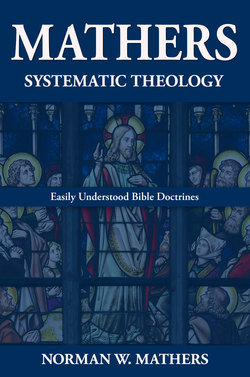Читать книгу Mathers Systematic Theology - Norman W. Mathers - Страница 10
1.3 The Living Word of God
ОглавлениеThe Living Word is Jesus Christ. “No one has seen God at any time the only begotten” (the monogenes – used of the eternal word who was in fellowship with the Father in eternity past –John 1:1) “the one being in the bosom of the Father that one He himself has exegeted” (explained) [the Father] [author’s translation] (John 1:18) (Aland & Black 1968:322). John 1:18 refers to sense perception of special revelation. God is not perceived through our senses. In the Old Testament, Moses and Jacob did see God face to face. John 14:5 gives a further explanation of John 1:18. Thomas admitted that rationalism (oidamen – know with the mind – used of intellectual knowledge) is not sufficient to see God. His question was:
“How are we ourselves able to know the way?” (14:5) [author’s translation] (Aland & Black 1968:386). Jesus answers that He is the special revelation of God (14:6). No one is able to be saved except through Him. Philip’s response demonstrates that sense perception is not enough to know God (14:8). He had a simple request. “Start showing us the Father and it satisfies us” (John 14:8) [author’s translation] (Aland & Black 1968:387). Jesus replied that he who had seen him had seen the Father. Orao (this is from the Greek verb to see) is used in scripture of spiritual perception. It took a revelation from the Father to understand the person of Christ (Matt. 16:7).
The theology of the Living Word, Jesus Christ, is the focus of the epistles of Colossians and Hebrews. Owen (1977:5) argues in this fashion. He points out that Colossians 1:17 argues for the fact that the Son of God holds the universe together by His power. The atomic structure- each atom a mini solar system- is traced to the omnipotence of the Son of God. Hebrews 1:3 testifies to the deity, omnipotence, and authority of the eternal Son of God (ibid:50). Christ was the creator of things visible and invisible (angelic realms) (Col. 1:16). Christ is “effulgence of His glory and express image” (character) “of His essence or substance” (Heb. 1:3) [author’s translation] (Aland & Black 1968:747). The brightness (effulgence) of His glory means Christ is God of very God (Owen 1977:5). The apostle John tells us that he beheld Christ’s glory “and the Word became flesh, and tabernacled among us, and we ourselves have beheld his glory as monogenes” (the one in eternal fellowship with the Father – John 1:1) “from the Father full of grace and truth” (John 1:14) [author’s translation] (Aland & Black 1968:321). Christ was the same essence as the Father (Moffatt 1975:7). Christ was God of very God. Owen argues that the brightness of His glory is an Old Testament reference to the truth of Jehovah God dwelling with His people (Zech. 2:8). Jehovah had sent the son. All that the Father is the Son is as well (Owen 1977:5). In addition, the writer of Hebrews adds that He (Christ) is the express image of His person. He is God of very God. The fullness of deity dwells in Christ bodily (Col. 1:19; 2:9). “The radiance of his glory” (Heb. 1:3) [author’s translation] (Aland & Black 1968:747) means Christ manifested the glory of God because he was God (Moffatt 1977:6-7). Christ is “same of His essence” (Heb. 1:3) means that Christ is all that the Father is God of very God. The church councils of Nicea (325 A.D.), Constantinople (381 A.D.), and Ephesus (431 A.D.) upheld the deity of the person of Christ (Douglas, Cairns, et al (eds.) 1974:706,381,344). Cairns (1974:144-145,148-149) confirms this fact.
Revelation in the Old and New Testaments is progressive (Chafer 1971:1:60). This means that revelation was given at different times to different writers in different ages. The Bible was produced by these different authors over a period of 1500 years. Isaiah knew more concerning the suffering servant than did Abraham (Gen. 22:7-8; Is. 53:1-12). The progressive revelation of God in revealing the scriptures does not nullify any earlier revelation. Later revelation adds to earlier revelation. This subsequent revelation adds additional details, truth, clarifies, and completes earlier revelation. We find Old Testament principles set down that become the basis for the way the New Testament is interpreted. An example of this would be the just shall live by faith. This is found in Habakkuk 2:4. Paul presents this Old Testament principle as the theme of the epistle to the Romans (1:17). Progressive revelation adds completeness to earlier revelation received (Chafer 1971:1:72-85).
In analysis, the Living Word, the Lord Jesus Christ is the eternal Son of God. He was fully God while He was on the earth. The apostles saw the glory of God in Christ (John 1:18). The Logos is the revealer of God. The New Testament confirms the deity of Christ (Col. 1:16-19; 2:9; Heb. 1:1-3). Revelation is understood as progressive in nature. The writers of scripture received revelation at different times during different periods of history. A central passage for revelation is 1 Corinthians 2:9-10.
